Understanding Toughening Mechanisms and Damage Behavior in Hybrid-Fiber-Modified Mixtures Using Digital Imaging
Abstract
:1. Introduction
2. Materials and Methods
2.1. Raw Material
2.1.1. Calcium Sulfate Whisker
2.1.2. Basalt Fiber
2.2. Design and Preparation of Mixture
2.2.1. Grading Design of Mixture
2.2.2. Preparation of SCB Test Sample
2.3. Experimental Design of SCB Based on Digital Image Method
3. Results and Discussion
3.1. Analysis of Fracture Process of Mixture Based on SCB Test
3.1.1. Load–Vertical Displacement Curve
3.1.2. Load–CMOD Displacement–Time Curve
3.1.3. Crack Propagation Speed
3.2. Analysis of Crack Resistance of Mixture Based on Fracture Mechanics
3.2.1. Fracture Toughness
3.2.2. Fracture Energy
3.2.3. Crack Resistance Index
3.3. Characterization of Fracture Interfaces on the Toughening Mechanism of Hybrid Fiber Modified Mixture
4. Conclusions
- (1)
- At the same temperature, BF can widen the toughness area of asphalt mixture, reduce the stiffness of mixture, increase the residual load at the same displacement, and improve the crack resistance of asphalt mixture matrix. CSW increases the peak load of the mixture, but the stiffness modulus is large, which is unfavorable to the crack toughness of the mixture.
- (2)
- The hybrid-fiber-modified mixture has the slowest crack propagation speed, the smallest absolute value of post-peak curve slope, the largest toughness band width, the largest fracture energy and crack resistance index, the strongest ability to prevent crack propagation, and the best toughness at low temperature.
- (3)
- CSW-modified asphalt mixture absorbs the most energy in the process of fracture and has the highest fracture toughness, but the fracture energy and crack resistance index are small, the crack propagation speed is the fastest, and the toughness is poor, which indicates that the fracture toughness parameters have strong limitations.
- (4)
- The interface characteristics show that BF can increase the asphalt film thickness on the surface of aggregate, disperse the concentrated stress in asphalt mastic, and limit the relative displacement of fine aggregate. CSW can improve the viscoelastic properties of asphalt, improve the interfacial adhesion between materials, and strengthen the fiber reinforcement.
- (5)
- BF is randomly distributed in asphalt mixture in three dimensions and overlapped with each other to form a spatial network structure, which improves the overall tensile strength of asphalt mixture, delays the development speed of cracks, and effectively improves the crack resistance of asphalt mixture.
Author Contributions
Funding
Data Availability Statement
Conflicts of Interest
References
- He, Y.; Li, Y.; Zhang, J.; Xiong, K.; Huang, G.; Hu, Q.; Zhao, X. Performance evolution mechanism and affecting factors of emulsified asphalt cold recycled mixture performance: A state-of art review. Constr. Build. Mater. 2024, 411, 134545. [Google Scholar] [CrossRef]
- Joumblat, R.; Kassem, H.A.; Basiouni, A.; Masri, A.Z.; Khateeb, G.A.; Absi, J. Performance evaluation of hot-mix asphalt with municipal solid waste incineration fly ash using the stress sweep rutting test. Innov. Infrastruct. Solutons 2023, 8, 261. [Google Scholar] [CrossRef]
- He, Y.; Wang, Q.; Zhang, J.; Li, Y.; He, H.; Huang, G. Foamed crumb rubber asphalt binder: Preparation, rheological properties and adhesion characteristics. J. Clean. Prod. 2023, 396, 136516. [Google Scholar] [CrossRef]
- He, Y.; Zhang, J.; Gao, B.; Wang, L.; Li, Y.; Guo, F.; Huang, G. Experimental investigation of the interface interaction between asphalt binder and mineral filler from the aspects of materials properties. Constr. Build. Mater. 2023, 393, 132094. [Google Scholar] [CrossRef]
- Dai, J.; Jia, X. Fatigue Performance of High-Modulus Basalt Fiber-Reinforced Asphalt Mixture. J. Appl. Sci. Eng. 2023, 26, 1444. [Google Scholar] [CrossRef]
- He, Y.; Rao, R.; Zhang, J.; Li, Y.; Xiong, K.; Li, Y.; Hu, Q.; Huang, G. Investigation on the rheological properties and modification mechanism of waste badminton shuttlecock modified asphalt binder. Environ. Technol. Innov. 2024, 34, 103561. [Google Scholar] [CrossRef]
- Ai, X.; Yi, J.; Pei, Z.; Zhong, J.; Zhou, W.; Feng, D. Application of waste rice straw as fibre or filler in asphalt mixtures: Materials characterisation and performance evaluation. Int. J. Pavement Eng. 2024, 25, 2334307. [Google Scholar] [CrossRef]
- Liu, Y.; Yang, Z.; Luo, H. Experimental Investigation of Eco-Friendly Anhydrous Calcium Sulfate Whisker and Waste Cooking Oil Compound Modified Asphalt Mixture. Materials 2023, 16, 2409. [Google Scholar] [CrossRef]
- Guan, B.; Liu, J.; Wu, J.; Liu, J.; Tian, H.; Huang, T.; Liu, C.; Ren, T.; Grilli, A. Investigation of the Performance of the Ecofriendly Fiber-Reinforced Asphalt Mixture as a Sustainable Pavement Material. Adv. Mater. Sci. Eng. 2019, 2019, 6361032. [Google Scholar] [CrossRef]
- Bai, X.; Wang, L.; Chen, X. Multiscale Study on Low Temperature Crack Resistance Mechanism of Steel Slag Asphalt Mixture. J. Wuhan Univ. Technol.-Mat Sci Ed. 2024, 39, 705–715. [Google Scholar] [CrossRef]
- Wu, J.; Zhao, Z.; Jiang, C.; Yang, Y.; Zhishuai, S.; Jie, Y.; Feipeng, X. Recent development and application of natural fiber in asphalt pavement. J. Clean. Prod. 2024, 449, 141832. [Google Scholar] [CrossRef]
- Tanzadeh, J.; Shahrezagamasaei, R. Laboratory Assessment of Hybrid Fiber and Nano-silica on Reinforced Porous Asphalt Mixtures. Constr. Build. Mater. 2017, 144, 260–270. [Google Scholar] [CrossRef]
- Gong, Y.; Song, J.; Bi, H.; Tian, Z. Optimization Design of the Mix Ratio of a Nano-TiO2/CaCO3-Basalt Fiber Composite Modified Asphalt Mixture Based on Response Surface Methodology. Appl. Sci. 2020, 10, 4596. [Google Scholar] [CrossRef]
- Ren, D.; Luo, W.; Su, S.; Wang, Z.; Kong, L.; Ai, C. Study on crack resistance of basalt fiber reinforced asphalt mixture modified by titanate coupling agent based on digital image correlation. Constr. Build. Mater. 2024, 437, 136934. [Google Scholar] [CrossRef]
- Saha, G.; Biligiri, K.P. Fracture properties of asphalt mixtures using semi-circular bending test A state-of-the-art review and future research. Constr. Build. Mater. 2016, 105, 103–112. [Google Scholar] [CrossRef]
- Li, C.; Wang, L.; Wang, X. Crack and crack growth behavior analysis of asphalt mixtures based on the digital speckle correlation method. Constr. Build. Mater. 2017, 147, 227–238. [Google Scholar] [CrossRef]
- Kutuk-Sert, T.; Ozturk, M.; Kutuk, S. Digital image processing of warm mix asphalt enriched with nanocolemanite and nanoulexite minerals. Constr. Build. Mater. 2023, 399, 132542. [Google Scholar] [CrossRef]
- Rusli, R.; Shanmuganathan, K.; Rowan, S.J.; Wedar, C.; Eichorn, J.S. Stress Transfer in Cellulose Nanowhisker Composites—Influence of Whisker Aspect Ratio and Surface Charge. Biomacromolecules 2011, 12, 1363. [Google Scholar] [CrossRef]
- Saulat, H.; Cao, M.; Khan, M.M.; Khan, M.; Khan, M.M.; Rehman, A. Preparation and applications of calcium carbonate whisker with a special focus on construction materials. Constr. Build. Mater. 2020, 236, 117613. [Google Scholar] [CrossRef]
- Hu, K.; Zhou, J.; Han, S.; Chen, Y.; Zhang, W.; Fan, C.; Fan, C. Silane coupling agent enhances recycle aggregate/asphalt interfacial properties an experimental and molecular dynamics study. Mater. Today Commun. 2024, 39, 108681. [Google Scholar] [CrossRef]
- Fan, T.; Wang, X. Influence of calcium sulfate whisker on the high temperature performance of asphalt binder. Pet. Sci. Technol. 2020, 38, 303–308. [Google Scholar] [CrossRef]
- Ren, D.; Luo, W.; Wang, Z.; Su, S.; Kong, L.; Ai, C. Enhancing the Adhesion Interface Between Asphalt and Basalt Fibers Through Surface Modification with Titanate Coupling Agents. Arab. J. Sci. Eng. 2024, 49, 5547–5563. [Google Scholar] [CrossRef]
- Xing, X.; Chen, S.; Li, Y.; Pei, J.; Zhang, J.; Wen, Y.; Li, R.; Cui, S. Effect of different fibers on the properties of asphalt mastics. Constr. Build. Mater. 2020, 262, 120005. [Google Scholar] [CrossRef]
- JTG F40-2004; Technical Specifications for Construction of Highway Asphalt Pavements. Research Institute of Highway Ministry of Transport: Beijing, China, 2004.
- JTG E42-2005; Test Methods of Aggregate for Highway Engineering. Research Institute of Highway Ministry of Transport: Beijing, China, 2005.
- Kutuk, S.; Kutuk-Sert, T. An examination of nanoparticle colemanite mineral added warm mix asphalt. Constr. Build. Mater. 2020, 243, 118252. [Google Scholar] [CrossRef]
- Wu, H.; Ji, X.; Song, W.; Deng, Z. Multi-scale analysis on fracture behaviors of asphalt mixture considering moisture damage. Constr. Build. Mater. 2024, 416, 135234. [Google Scholar] [CrossRef]
- Tarefder, R.A.; Kias, E.M.; Ng, T. Factors affecting cracking of notched asphalt concrete. Int. J. Pavement Res. Technol. 2009, 2, 137–147. [Google Scholar]
- He, Y.; Xiong, K.; Zhang, J.; Guo, F.; Li, Y.; Hu, Q. A state-of-the-art review and prospectives on the self-healing repair technology for asphalt materials. Constr. Build. Mater. 2024, 421, 135660. [Google Scholar] [CrossRef]
- Zhu, Y.; Dave, E.V.; Rahbar-Rastegar, R.; Sias, D.J.; Zofka, A. Comprehensive evaluation of low-temperature fracture indices for asphalt mixtures. Road Mater. Pavement Des. 2017, 18, 467–490. [Google Scholar] [CrossRef]
- Kaseer, F.; Yin, F.; Arámbula-Mercado, E.; Amy Epps, M.; Jo Sias, D.; Saman, S. Development of an index to evaluate the cracking potential of asphalt mixtures using the semi-circular bending test. Constr. Build. Mater. 2018, 167, 286–298. [Google Scholar] [CrossRef]
- Nian, T.; Wang, M.; Ge, J.; Guo, R.; Li, P.; Song, J. Enhancing low-temperature crack resistance, A method for establishing meso-models and evaluating steel fiber-reinforced hot recycled asphalt mixtures. Constr. Build. Mater. 2024, 438, 137026. [Google Scholar] [CrossRef]


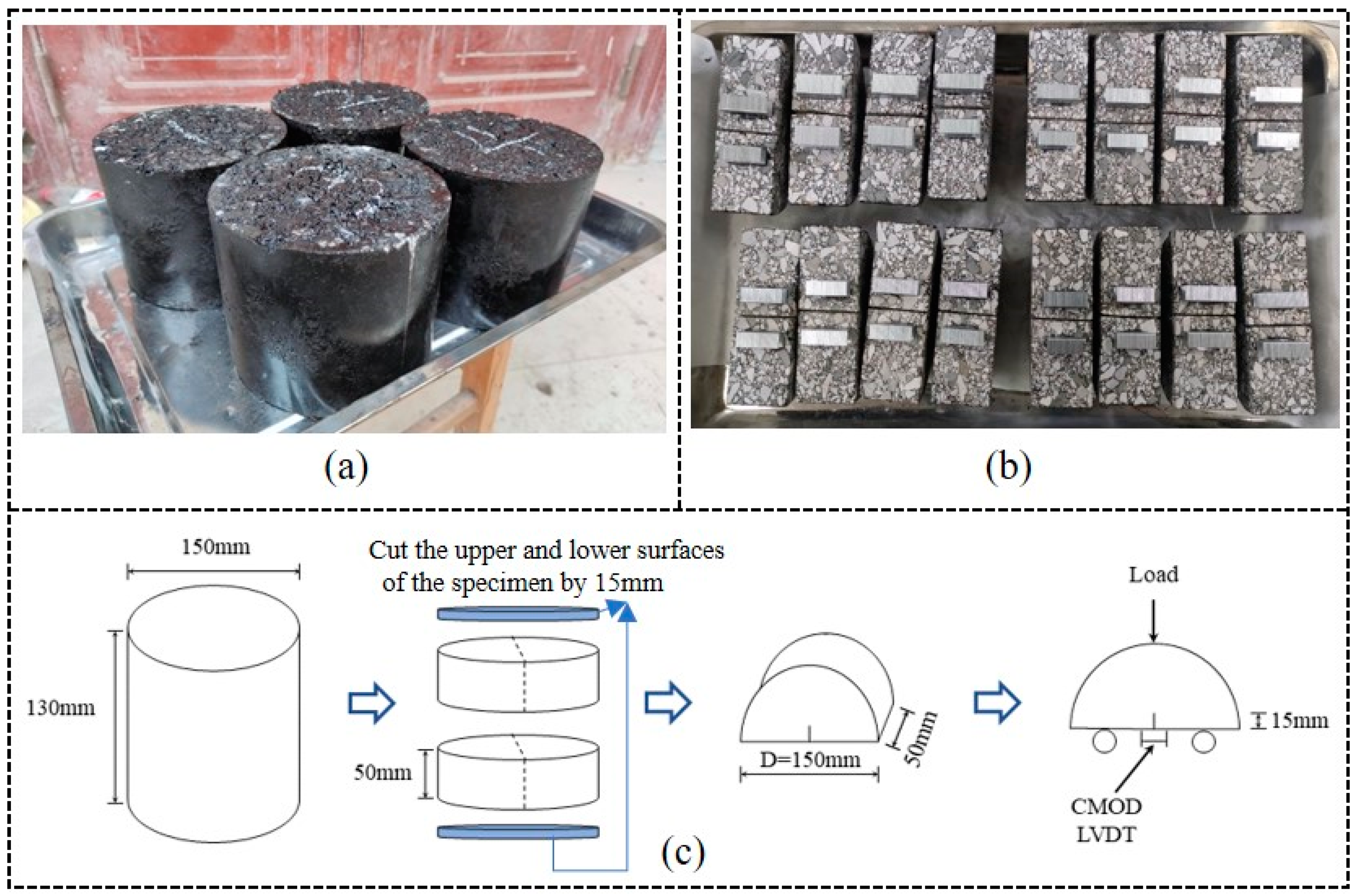

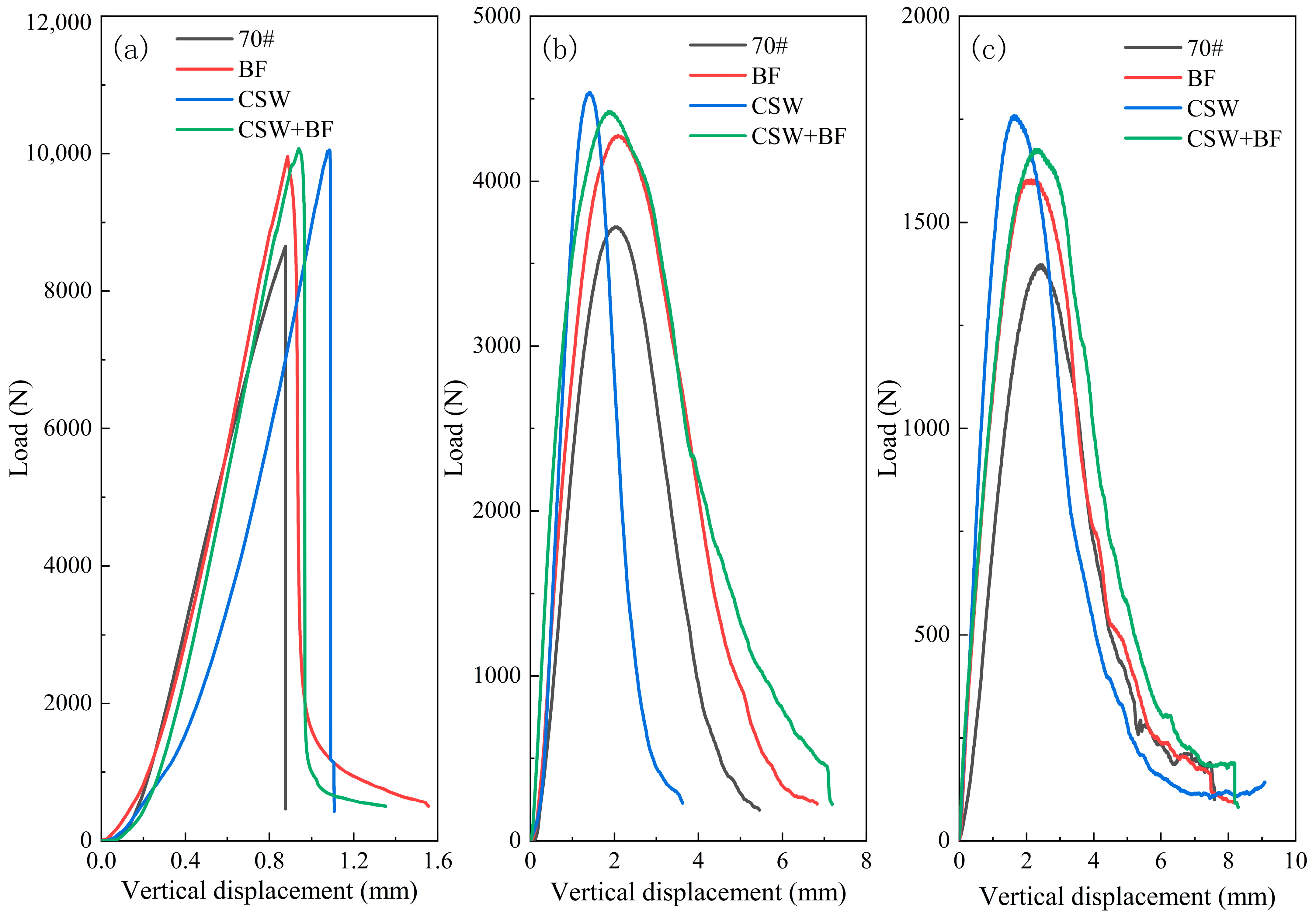
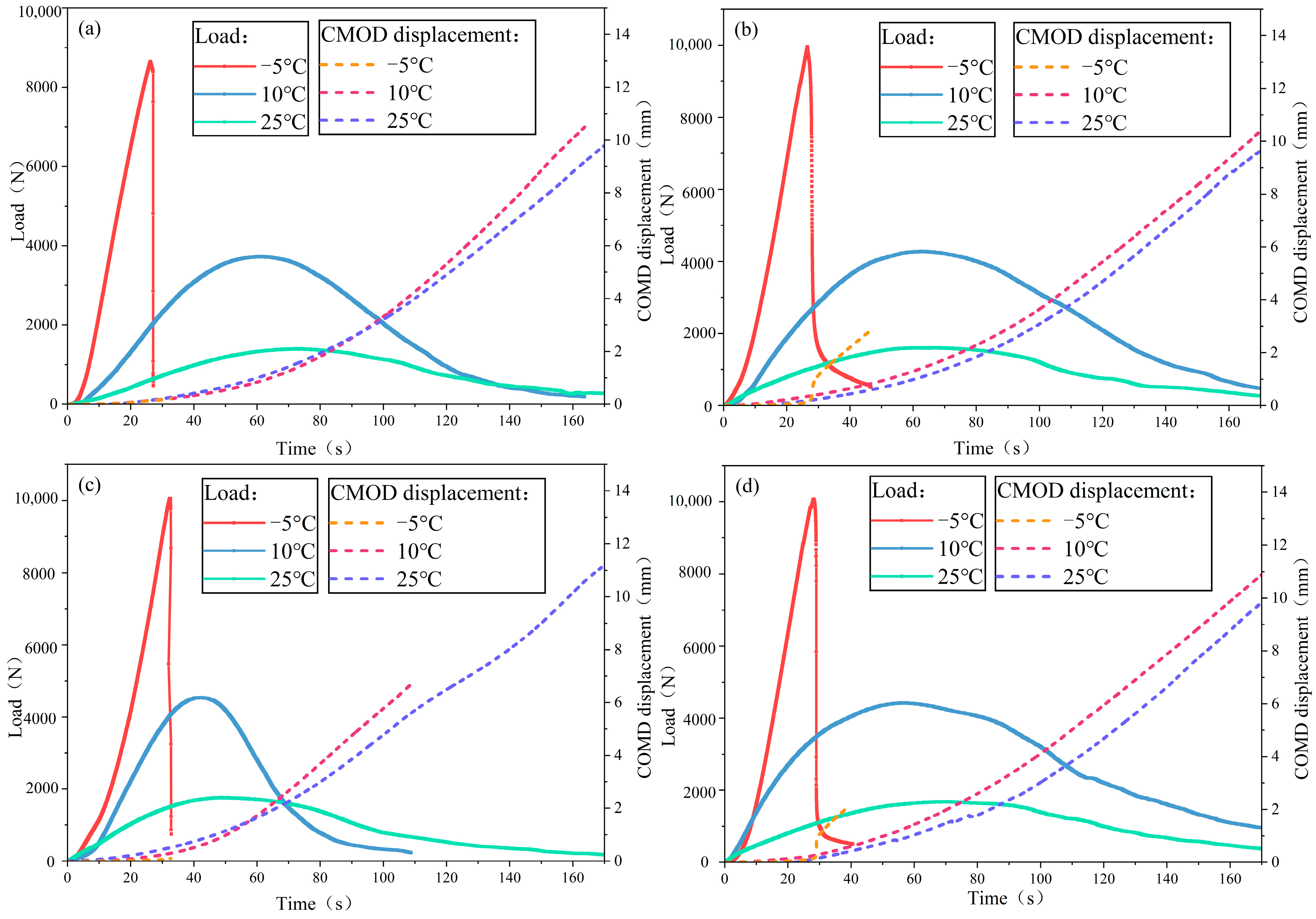
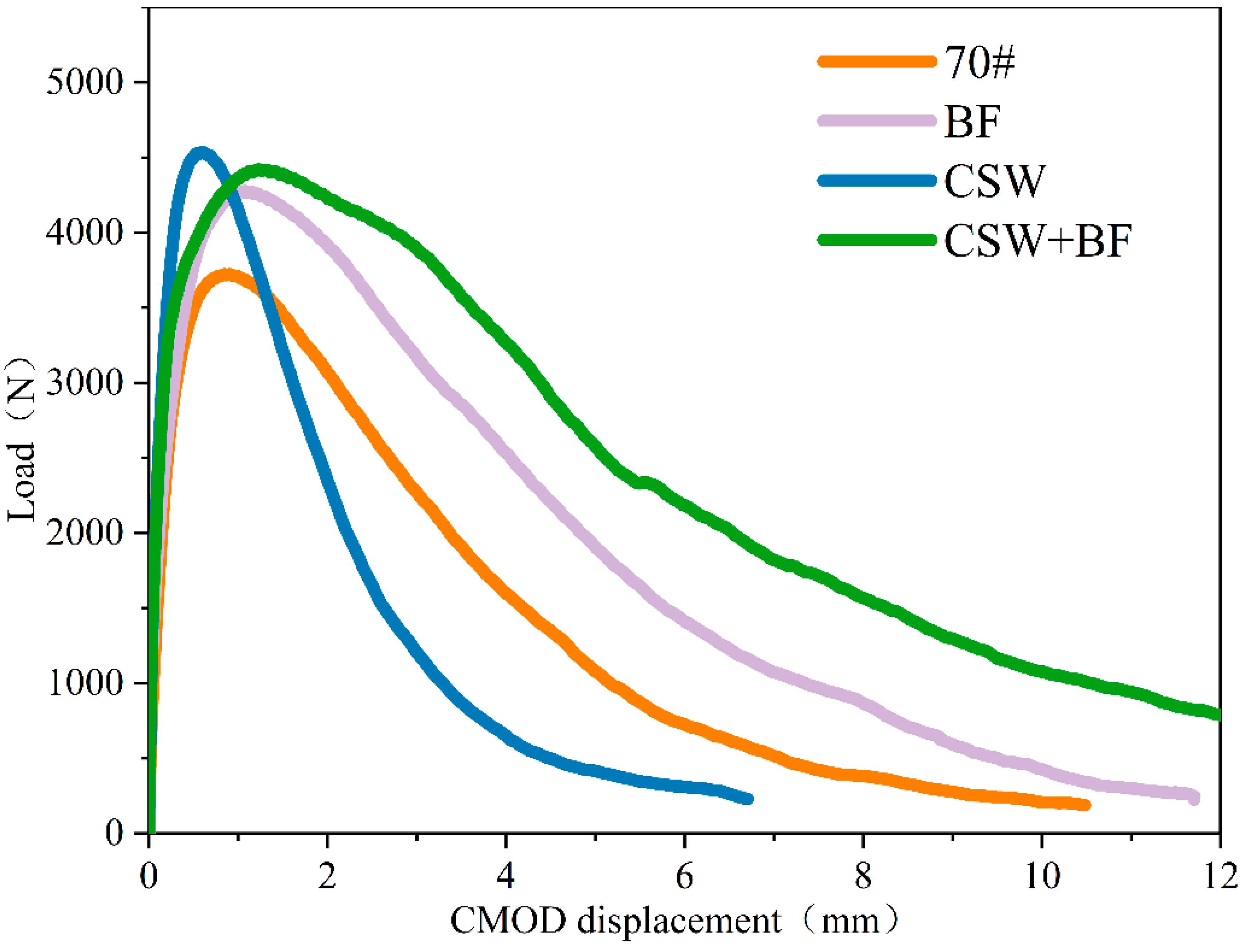
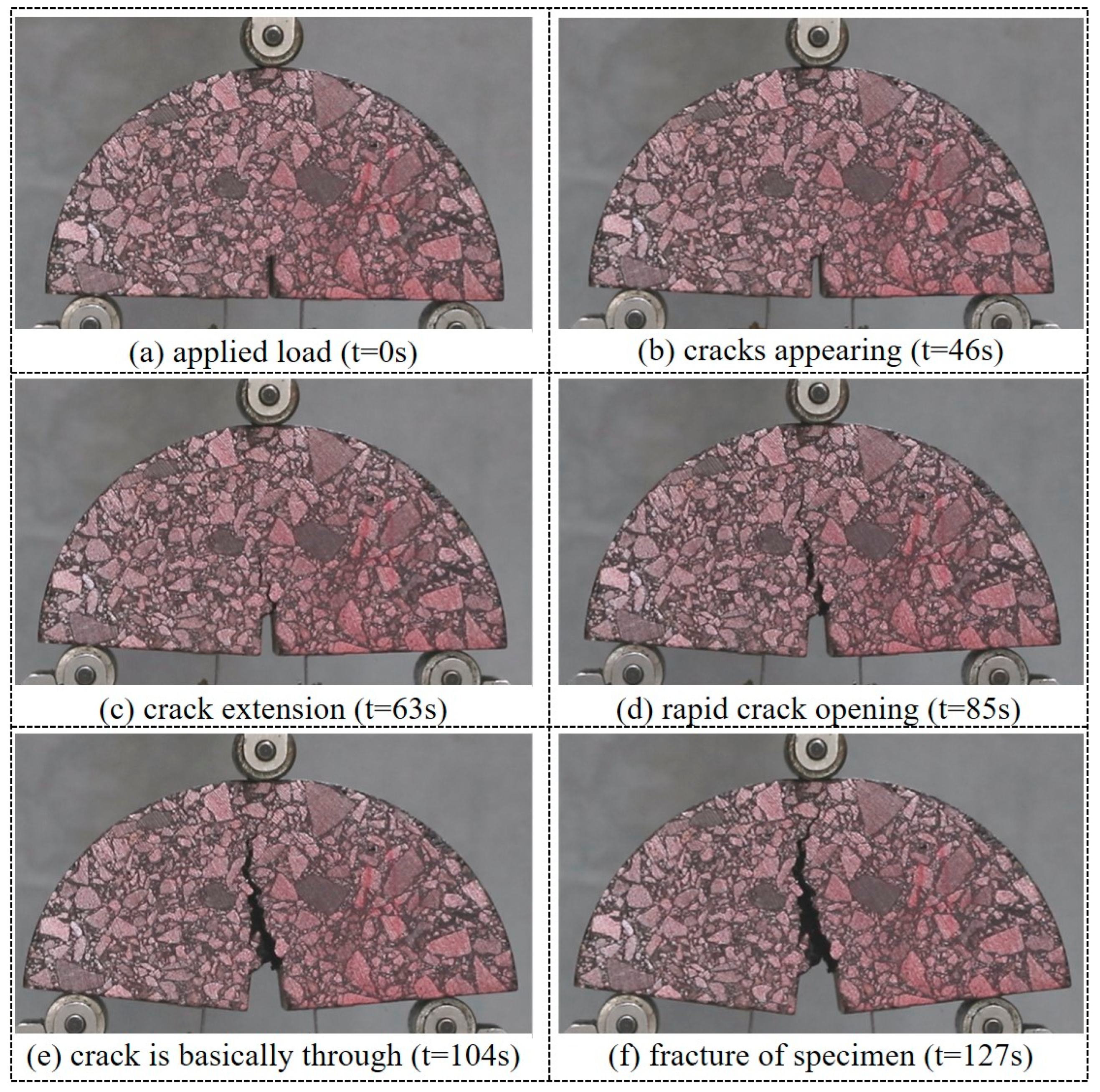

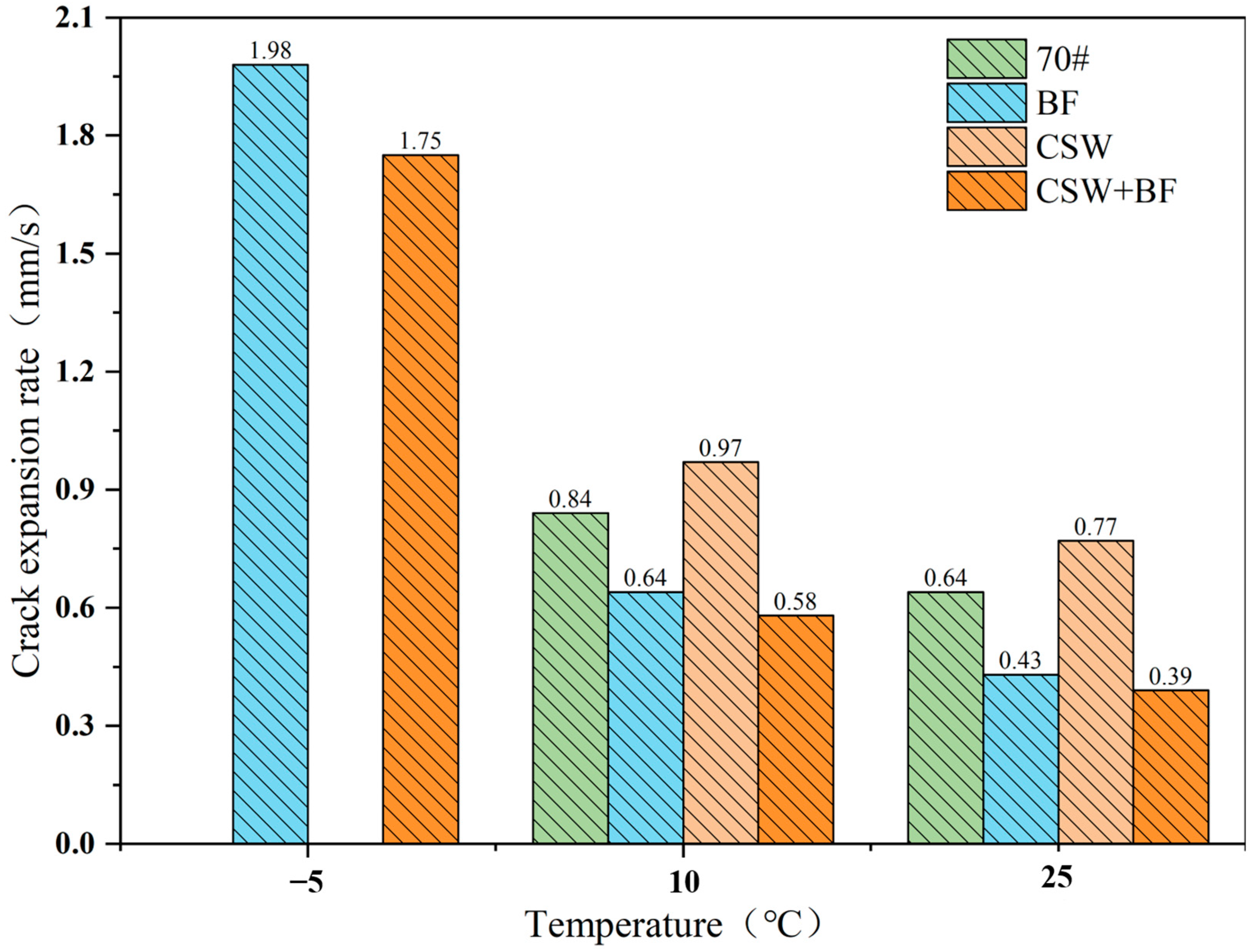
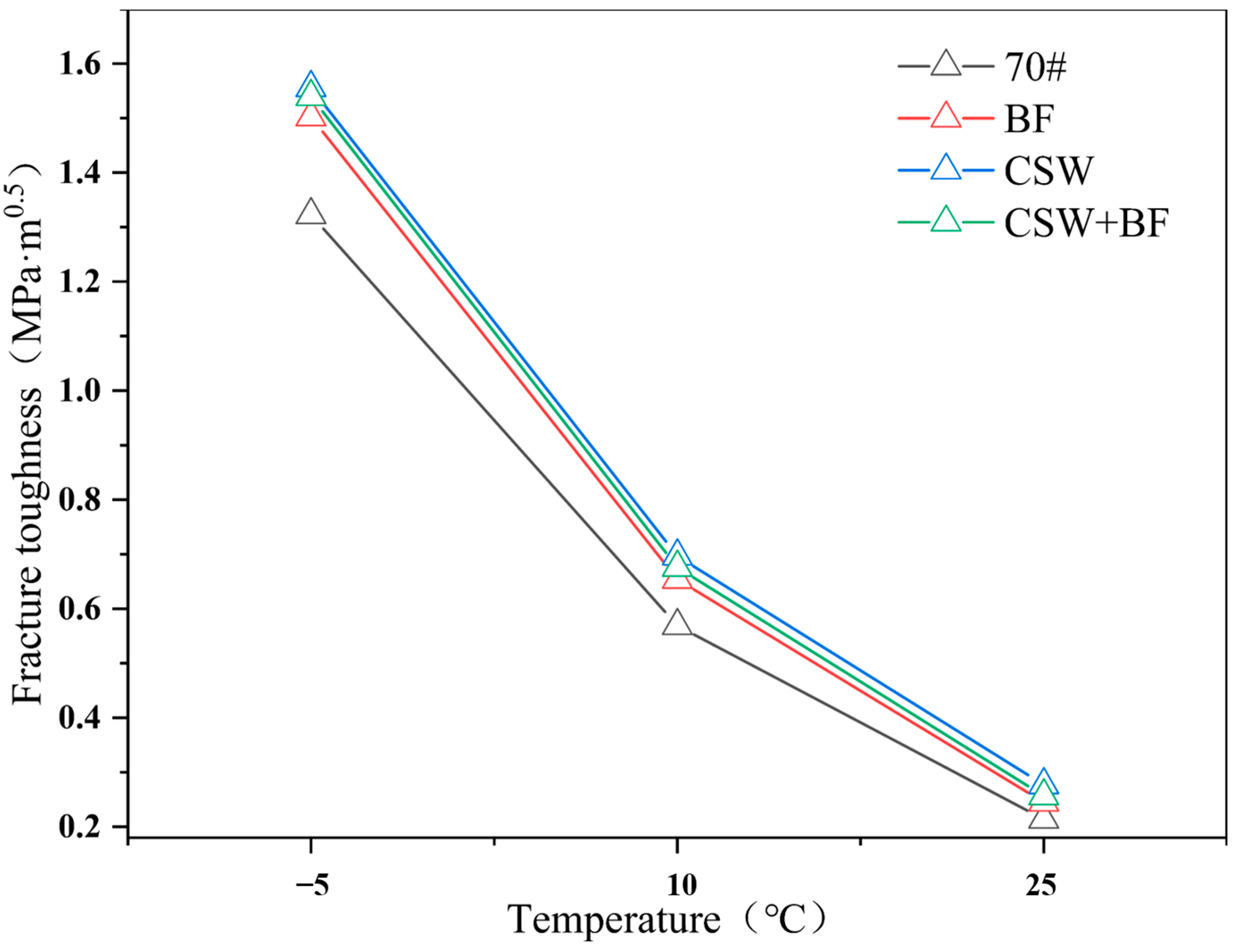
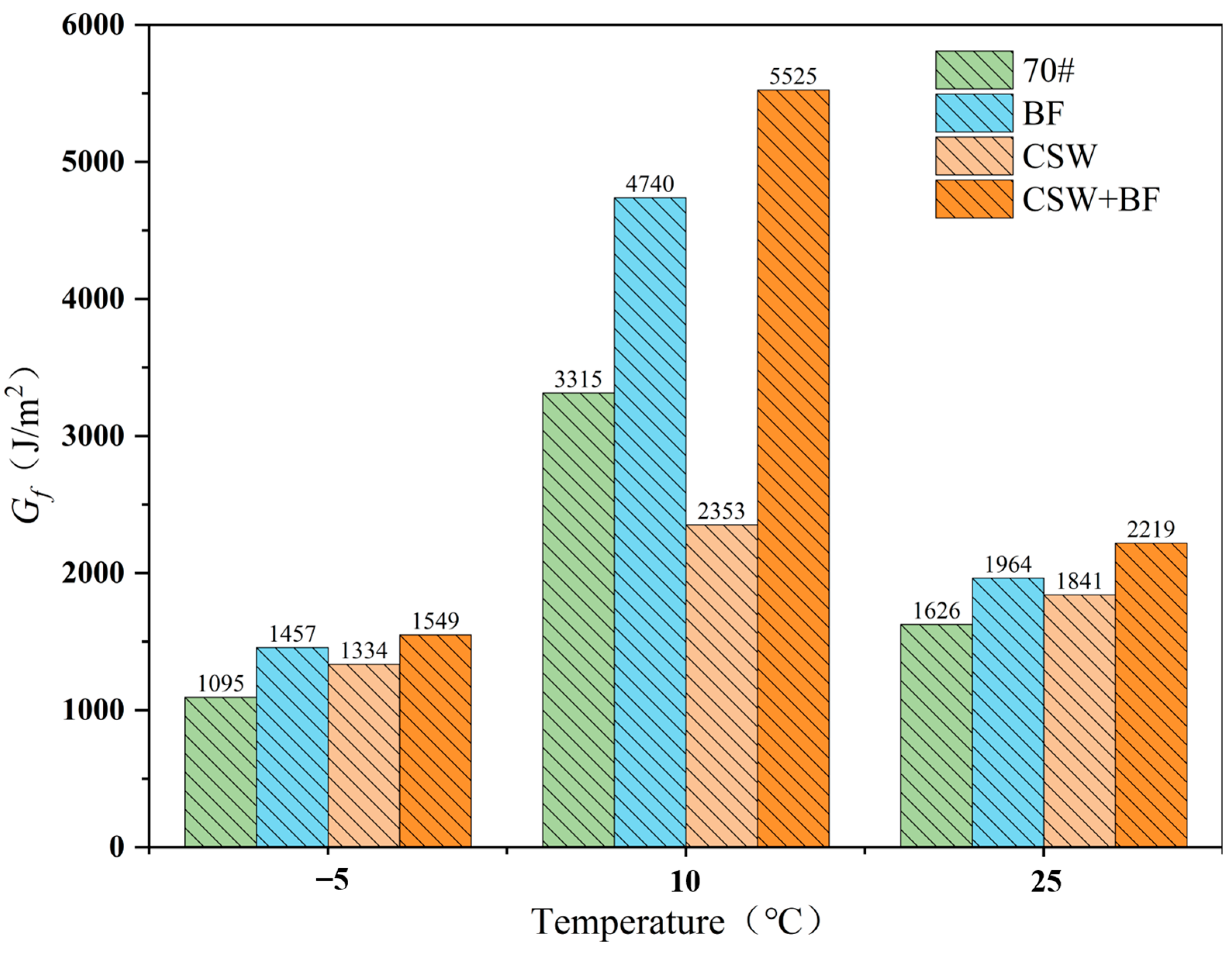
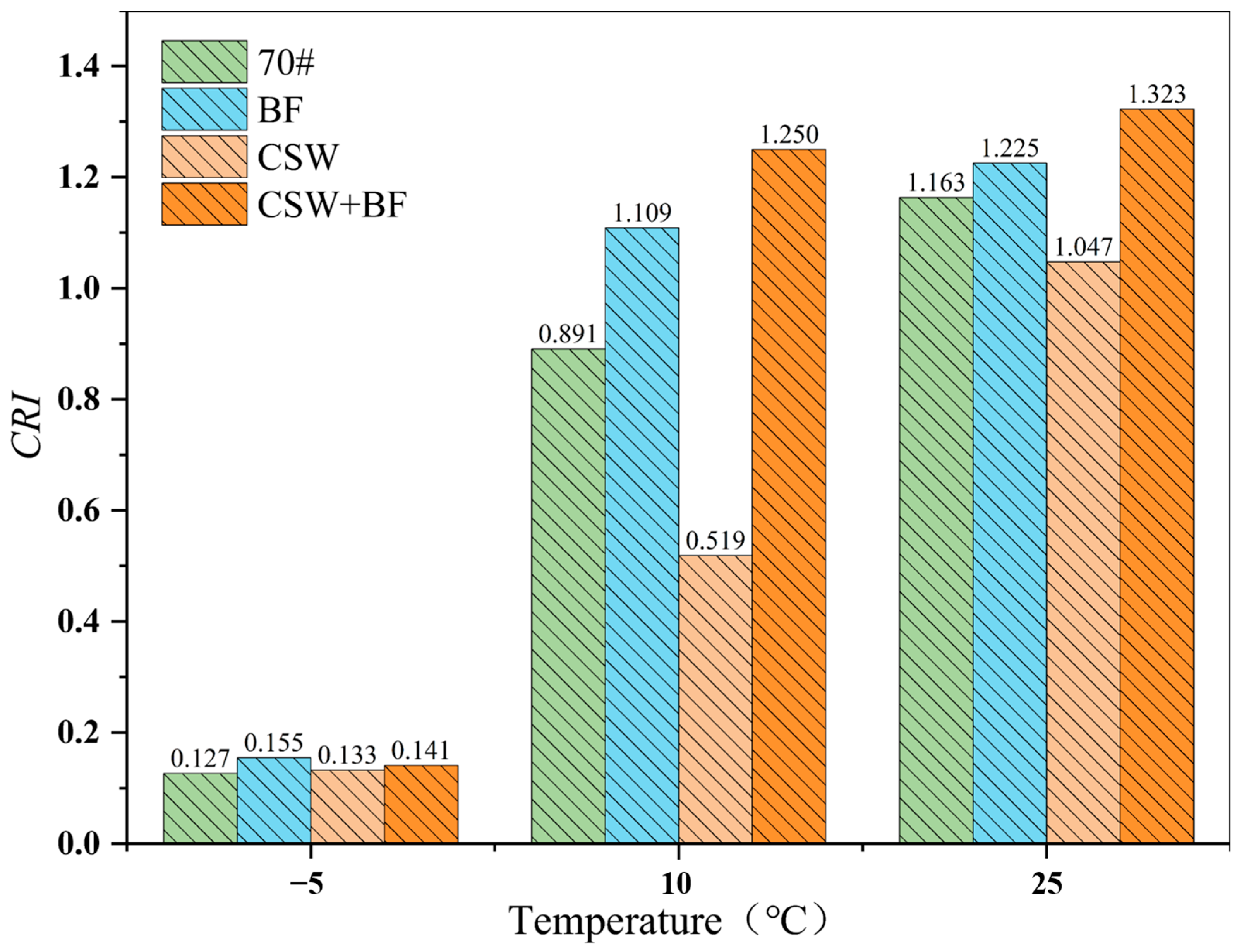
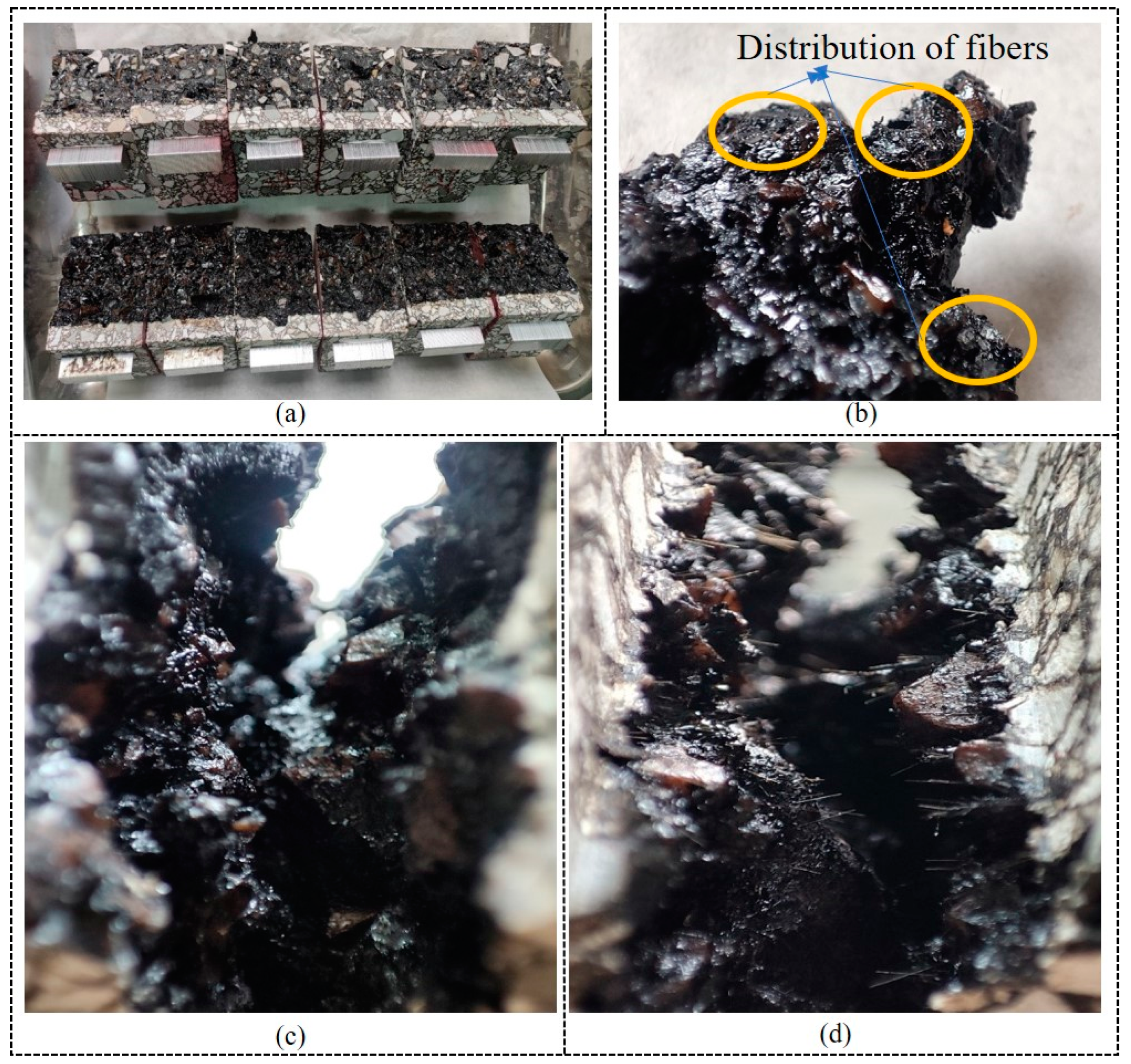
| Project | Result | Unit |
|---|---|---|
| Appearance | White powder | -- |
| Loose density | 0.15–0.3 | g·cm−3 |
| Density | 2.69 | g·cm−3 |
| Diameter | 1–15 | μm |
| Average length | 20–35 | μm |
| Aspect ratio | 20–35 | -- |
| Mohs hardness | 3 | -- |
| Project | Result | Unit |
|---|---|---|
| Length | 6 | Mm |
| Diameter | 15 | Μm |
| Density | 2.64 | g·cm−3 |
| Tensile strength | 3000 | MPa |
| Elasticity modulus | 65.2 | GPa |
| Elongation at break | 2.58 | % |
| Melting point | 79.1 | °C |
| Mass loss (thermal stability) | 0.47 | % |
| Moisture absorption rate (water stability) | 0.8 | % |
| Oil absorption multiple (oil absorption) | 6.048 | -- |
| Oil-Stone Ratio (%) | Relative Density of Gross Volume (g/cm3) | Void Ratio (%) | Gap Rate of Mineral Aggregate (%) | Saturation (%) | Stability (kN) | Flow Value (0.1 mm) |
|---|---|---|---|---|---|---|
| 3.0 | 2.386 | 7.1 | 13.90 | 48.3 | 6.54 | 3.59 |
| 3.5 | 2.401 | 5.8 | 13.72 | 57.6 | 8.02 | 2.79 |
| 4.0 | 2.420 | 4.3 | 13.43 | 67.5 | 10.23 | 2.38 |
| 4.5 | 2.445 | 3.0 | 13.17 | 78.1 | 9.57 | 2.70 |
| 5.0 | 2.468 | 1.9 | 13.06 | 86.2 | 7.06 | 3.48 |
Disclaimer/Publisher’s Note: The statements, opinions and data contained in all publications are solely those of the individual author(s) and contributor(s) and not of MDPI and/or the editor(s). MDPI and/or the editor(s) disclaim responsibility for any injury to people or property resulting from any ideas, methods, instructions or products referred to in the content. |
© 2024 by the authors. Licensee MDPI, Basel, Switzerland. This article is an open access article distributed under the terms and conditions of the Creative Commons Attribution (CC BY) license (https://creativecommons.org/licenses/by/4.0/).
Share and Cite
Yang, Y.; He, Y.; Fu, R.; Zhao, X.; Shang, H.; Ma, C. Understanding Toughening Mechanisms and Damage Behavior in Hybrid-Fiber-Modified Mixtures Using Digital Imaging. Buildings 2024, 14, 2562. https://doi.org/10.3390/buildings14082562
Yang Y, He Y, Fu R, Zhao X, Shang H, Ma C. Understanding Toughening Mechanisms and Damage Behavior in Hybrid-Fiber-Modified Mixtures Using Digital Imaging. Buildings. 2024; 14(8):2562. https://doi.org/10.3390/buildings14082562
Chicago/Turabian StyleYang, Yaohui, Yinzhang He, Rui Fu, Xiaokang Zhao, Hongfa Shang, and Chuanyi Ma. 2024. "Understanding Toughening Mechanisms and Damage Behavior in Hybrid-Fiber-Modified Mixtures Using Digital Imaging" Buildings 14, no. 8: 2562. https://doi.org/10.3390/buildings14082562





